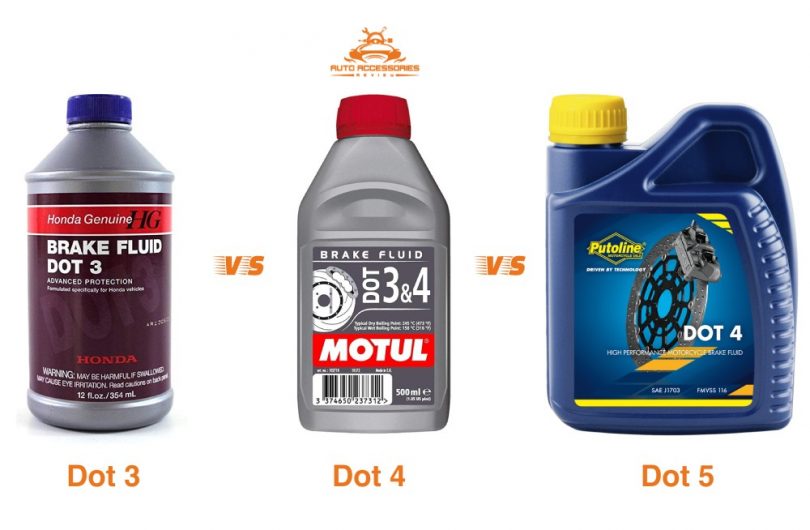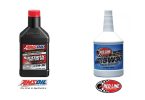Brake fluids are used to lubricate the brake calipers and offer corrosion resistance with a high boiling point. They are available in different types but DOT 3, DOT 4, and DOT 5 are the most commonly used ones.
Our in-depth brake fluid comparison will help you decide which one is right for you.
Things to Like About DOT 3 Brake Fluids

High boiling points
The boiling point of dry DOT 3 brake fluid is 205° C, and the boiling point of wet DOT 3 brake fluid is 140° C
Minimal rubber component swell
It minimizes leakage and fluid loss.
Widely used in clutches and brakes
It’s great for filling brake or clutch systems for the first time or recharging. Before first filling or refilling, flush the system with Penrite Brake Fluid DOT 3.
Designed for use with heavy-duty vehicles
The brake fluid can be used to top up or refill clutches and brake systems of commercial vehicles, motorcycles, and four-wheel-drive vehicles, as well as personal vehicles
A high level of safety and consistency
When borate is added to the fluid, the brakes work more efficiently, improving the vehicle’s overall performance.
Things to Like about DOT 4 Brake Fluids

Borate esters improve their performance
Borate esters mixed with polyethylene glycol ethers and high-performance inhibitors and additives give ultimate system protection.
An improvement over DOT 3
The boiling points of DOT 4 brake fluid are higher in dry and wet conditions, so it’s safer to use in high temperatures.
The product can be mixed with DOT 3 and DOT 5.1
DOT 3, 4, and 5.1 can be mixed in if it is fresh fluid. The only negative thing that can happen is the overall boiling point will drop.
Things to like about DOT 5 brake fluids

Higher boiling point
The higher price is due to the high boiling points. Dry boiling takes place at 260° C, while wet boiling takes place at 180° C
Almost all modern cars use it
Nowadays, most new cars use silicone-based brake fluid, known as DOT 5. In addition, brake rotors have become thinner and smaller in recent years, making them less efficient at dispersing heat.
Stable viscosity during extreme temperature fluctuations
DOT 5 does not change in viscosity at temperatures above 100°C.
Rust-resistant
This flui protects your brake system from rust by acting as a weather barrier.
DOT 3 vs DOT 4 vs DOT 5: What are the differences?
Chemical structure
DOT 3
DOT 3 brake fluid is mixed from ether and polyalkyelen glycol. The brake fluid will not crack under wet or moderately hot conditions using this mixture.
DOT 4
Borate and glycol are the main ingredients in DOT 4 brake fluid. Mixing these two substances helps improve the brake fluid’s stability and ability to withstand higher temperatures.
DOT 5
This brake fluid consists primarily of silicone.
Winner
There is no clear winner here as the DOT 5 won’t absorb water due to the silicone content. The DOT 3 and 4 have the chemicals added that allows them to withstand higher temperatures.
Color
DOT 3
Yellow
DOT 4
Yellow
DOT 5
Purple
Winner
The top two appear yellow from looking into the tin but turn almost clear when poured into a bottle. The purple color is bright and different.
Viscosity
DOT 3
The viscosity is 1500 mm2/s at -40 degrees Celcius and 1.5 mm2/s at 100 degrees Celcius.
DOT 4
For -40 degrees celsius, the viscosity is 1800 mm2/s and 1.5 mm2/s for 100 degrees celsius.
DOT 5
900mm2/s at -40 degrees Celcius and 100 degrees at 1.5mm2/s.
Winner
DOT 5 is the winner with the lowest viscosity. Viscosity refers to the ability of fluids to flow through narrow passageways. With heavier fluid, DSC activation and ABS responses will be slowed.
Dry boiling point
DOT 3
The boiling point of DOT 3 brake fluid is 400 degrees Fahrenheit under dry conditions.
DOT 4
In dry conditions, DOT 4 fluid boils at 450 degrees.
DOT 5
The boiling point of dry DOT 5 fluid is 500 degrees.
Winner
DOT 5 is the winner as it reaches the dry boiling point of 500 degrees which is the highest of the three
Wet boiling point
DOT 3
284-degrees
DOT 4
311-degrees
DOT 5
356-degree
Winner
Again dot 5 is the winner here, with the highest wet boiling point at 35 degrees.
Water absorption from the air
DOT 3
Absorbs fluid
DOT 4
Absorbs fluid
DOT 5
Silicone-based, it does not absorb water.
Winner
Nonsilicone fluids absorb silicon, causing their boiling point to decrease. This causes rust within the system and mushy brakes.
Mixing with other types of fluid
DOT 3
This type can be mixed with dot 4
DOT 4
This type can be mixed with dot 3
DOT 5
The silicone-based fluid does not mix with any other type of DOT fluid.
Winner
Here you can see that silicone-based DOT 5 is the odd one out and is not compatible with any other DOT brake fluid
Service life
DOT 3
At 60,000 km or every 18 months
DOT 4
60,000 km or every 18 months
DOT 5
60,000 km or every 18 months
Winner
All three brake fluids should be changed every 18 months or around the 60,000 km mark, whichever comes first. Their efficiency can be affected if you don’t change around these times.
Damaging painted surface
DOT 3
Yes, it can damage painted surfaces
DOT 4
The dot 4 like above can damage your cars paintwork
DOT 5
Does not damage any of the bodywork or paint it comes in contact with.
Winner
DOT 5 is the winner as it does not damage painted surfaces
Price
DOT 3
Around $35 per bottle
DOT 4
Around $50 per bottle
DOT 5
Around $50.00 per bottle
Winner
As you can see, the pricing goes up with each type. The dot 3 is budget-friendly but the dot 5 is better quality but more expensive.
DOT 3 vs DOT 4 vs DOT 5: Which one should you use for your vehicle?
Cars and trucks usually use DOT 3 brake fluid. It is a low-cost and typical option for those cars with drivers who don’t brake hard. Additionally, DOT 4 is becoming increasingly popular Anti-lock brakes and electronic stability control are compatible with this system. DOT 4 is ideal for cars that need to brake aggressively repeatedly, such as police and racing cars.
The boiling point of DOT 5 is high because it does not absorb water. Due to its silicone base, it prevents liquid from entering the braking system. Whenever moisture enters the brake system, it accumulates in pockets, eventually boiling off or freezing off. As a result, the brake system fails or is damaged.
FAQs
1. How does a dry boiling point differ from a wet boiling point?
Ans. In the case of brake fluids, the Dry Boiling Point is defined as the boiling point of fresh, unopened brake fluid. As opposed to the Wet Boiling Point, DOT brake fluid begins boiling after having absorbed 3.7% of its volume in water
2. Which brake fluid should I use in my vehicle?
Ans. It is best to consult your owner’s manual to determine the appropriate brake fluid for your vehicle. Check the master cylinder reservoir cap to determine what type of brake fluid is used in your car.










Leave a Comment